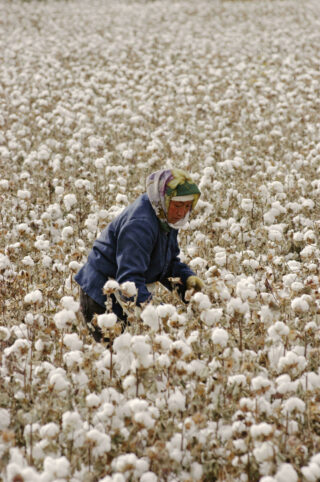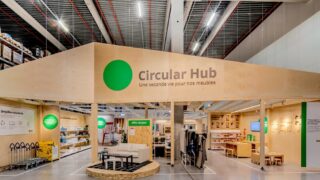6.1
6.1 Key trends
Sustainability and resilience are two sides of the same coin. COVID-19 and trade tensions have provided insights on the potential impact of supply-chain shocks, including those arising from extreme weather events. In part due to rising commodity prices and growing consumer commitment to sustainability, there are signs of a rapid take-off in platforms supporting the circular economy, in particular for the exchange of second-hand goods.
- Smart supply chains are essential for the shift to net zero, stopping human rights violations and ending deforestation.
- With rising commodity prices, scrutiny over resource-related impacts and carbon border charges, companies are rethinking their approach.
- The circular economy is taking shape, from the marketplaces in secondhand goods to smarter logistics platforms.
Global trade volumes suffered in the past year, but were already well below expectations in the years leading up to the pandemic. Supply-chain concerns spiked in the early days of the pandemic and roared back in early 2021. Supply chains are being tested in multiple ways: the pandemic, the climate crisis, cybersecurity, and trade-policy conflicts as part of broader geopolitical disputes.
Supply-chain disruption is resulting in spiking prices and delayed shipments. Producers are running down inventories and they struggle to restock.
Copper is a highly efficient conductor of electricity and heat. It is used in renewable energy systems to generate power from solar, hydro and others. High prices could dissuade investment.
Resource experts are also anticipating much finer differentiation between commodities according to their environmental and social performance, aided by smart technology.
There will be no one price for copper. There will be no more one price for gold. Everything will be priced in relation... to how much global-warming gas is created in making that commodity.
Robert Friedland
Many people have made radical behavioural changes during the pandemic. More people have woken up to the environmental impact of consumer choices.
Search interest in “sustainability” noticeably spiked in 2020.
E-commerce has seen three years of growth in one. Generation's research has shown that online shopping at large retailers in the United States is 17% more carbon-efficient than visiting traditional stores.
Consumers face a barrage of misleading information on sustainability. In the European Union, a recent survey found that half of all claims made by traders on environmental issues came with insufficient information for consumers to judge the claim's accuracy. Just under half were false or deceptive and could therefore potentially amount to unfair commercial practice.
National consumer protection authorities had reason to believe that in 42% of cases the claims were exaggerated, false or deceptive and could potentially qualify as unfair commercial practices under EU rules.
Miners are beginning to directly compete with each-other in terms of their ESG credentials to win commercial advantage, reshaping their business models where needed to achieve this.
Daniel Litvin, Critical Resource
6.2
6.2 Rethinking value chains for sustainability and resilience
This is likely to be the result of the disruption of the pandemic. However, the long-run trend is clearly towards more investment.
Mentions of “resilience” spiked last year, as more companies became concerned with ensuring that goods and services could continue to be delivered in the face of massive global disruption.
Concerns around human rights and cotton production go back many years, but they rose up the agenda this year with Xinjiang in western China. The response to allegations of forced labour of ethnic minorities in the region highlighted gaps between leaders and laggard companies.

Worker in a cotton field. Xinjiang Uyghur Autonomous Region. China. Image: agefotostock/ Alamy Stock Photo
Companies have increasingly been making commodity-level commitments to address deforestation. However, few companies are aligned with best practice when it comes to action.
In 2016, many companies agreed to end their contribution to deforestation by 2020, targets which in most cases have been missed.
$53 billion at risk from deforestation, yet only 1% of companies taking ‘best practice’ action
CDP
A power purchase agreement, or electricity power agreement, is a contract between two parties, one which generates electricity and one which is looking to purchase electricity. Global corporate PPA volumes are taking off.
Corporations purchased a record of 23.7GW of clean energy in 2020, up from 20.1GW in 2019 and 13.6GW in 2018.
More economic activity is being brought back onshore, as a result of trade-war worries and a desire for resilience. A positive “import-output ratio“ indicates net reshoring — the degree by which gross domestic output exceeded imports.
In the past, supply chain risks and sustainability challenges have often been governed by voluntary regimes or left to individual organisations to manage.
The EU is now expected to establish a mandatory due diligence regime for company supply chains in the coming months, aiming to raise the bar, tackle poor disclosure in key areas and avoid a fragmented approach. This builds on regulatory experience in the EU, US and other countries that has targeted specific commodities such as conflict minerals and illegal logging.
Separately, the EU is one of several jurisdictions looking to introduce a Carbon Border Adjustment Mechanism, which would apply a tariff for the embedded carbon in some goods entering the EU, where the exporting country is deemed not to be taking equivalent action on climate change. The aim is to ensure that domestic industries are not disadvantaged by tough climate policies.
6.3
6.3 Signs that the circular economy is finally taking shape
According to the Circularity Gap Report, circular-economy business models could cut global greenhouse gas emissions by 39% by 2032. Many new policy frameworks have been introduced in recent years to promote the circular economy. The aims include boosting employment and economic opportunity, reducing resource consumption and cutting emissions.
The economic value of circular-economy activity was clearly rising before the pandemic.
The rate at which materials were reused was rising solidly in the EU before the pandemic. More waste was also being recycled.
Takeout and an effort to reduce transmission have encouraged use of plastic. Interest in plastic containers has soared.
In the United States, the majority of plastic waste continues to end up in landfill. Globally, only 9% of the plastic ever produced has been recycled, according to a study by Geyer et al in 2017. Combustion/incineration is also highly emissions-intensive.
Cheaper new-plastic prices have encouraged single-uses.
2020 data for H1 only
2020 data for H1 only
Fast fashion continues to grow, but resale growth is much more impressive. Online second-hand purchases are soaring.
Resale is the sector of secondhand that includes more curated assortments, as opposed to traditional thrift and donation
Global interest in used goods is rising fast, according to analysis of Google-search trends.

Image:Ikea
The circular economy is much broader than the reuse of consumer goods.
For instance, as battery use continues to scale, they pose many supply chain challenges, from the minerals used in their production, through to end-of-life management. Work is underway across a number of fronts, from battery chemistries to reuse and recycling. In the EU, there are plans to implement a 'battery passport' to improve the traceability and encourage innovation.
The sustainable expansion of the battery value chain offers many environmental, social and economic benefits. It will, however, not be achieved without an active shift from the current development trajectory.
World Economic Forum, Sustainable Battery Alliance

